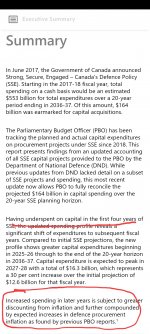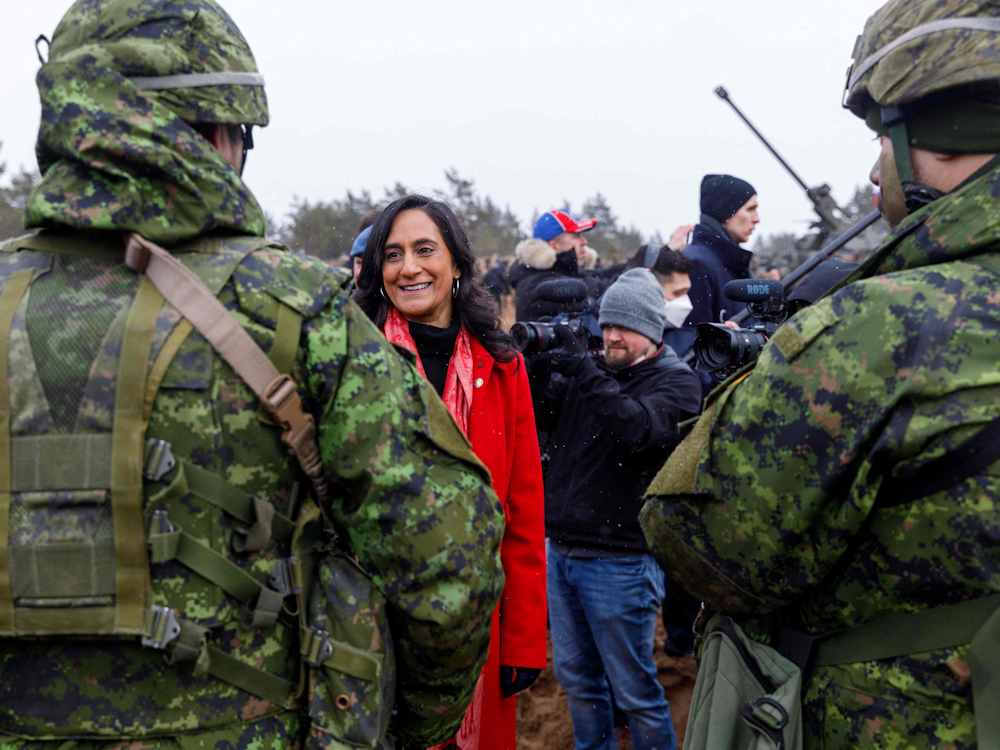I'll believe it when I see it.
You are using an out of date browser. It may not display this or other websites correctly.
You should upgrade or use an alternative browser.
You should upgrade or use an alternative browser.
Justin Trudeau hints at boosting Canada’s military spending
- Thread starter Maxman1
- Start date
- Reaction score
- 18,800
- Points
- 1,360
Put it this way….if an RCAF Spitfire that had flown air patrol over Normandy during D-Day was to fly, the same duration as Canada’s CF-18s have been to date, that Spitfire would have still been flying in front line service after we had received our first CF-18s…View attachment 69533
Cartoonist sums up my point with a picture.
- Reaction score
- 13,973
- Points
- 1,260
Then again, if an RCAF Spitfire was compared to USAF KC-135 or B-52, they would be still flying.Put it this way….if an RCAF Spitfire that had flown air patrol over Normandy during D-Day was to fly, the same duration as Canada’s CF-18s have been to date, that Spitfire would have still been flying in front line service after we had received our first CF-18s…
Blackadder1916
Army.ca Veteran
- Reaction score
- 2,167
- Points
- 1,160
Put it this way….if an RCAF Spitfire that had flown air patrol over Normandy during D-Day was to fly, the same duration as Canada’s CF-18s have been to date, that Spitfire would have still been flying in front line service after we had received our first CF-18s…
Then again, if an RCAF Spitfire was compared to USAF KC-135 or B-52, they would be still flying.
Or a Dak . . .
Canadian Warplanes 4: Douglas CC-129 Dakota
Harold writes articles on Canadian military history, including Military Parachuting, Warplanes, Armour and Artillery, Castles, Fortifications, Sieges and Battles, Warships, The Cold War, Women in the Canadian Forces, First Nations and Black Canadian Military Service. Each article is supported by...
Douglas Dakota Mk. III(Serial No. ), FZ671, C/N 12256, later (Serial No. 12944), in the markings of No. 437 Squadron, RCAF, coded Z-2B, painted as a Second World War camouflaged transport.
FZ671 was delivered to the No. 48 Squadron, RAF on 4 Feb 1944. This Dakota made at least two flights into Arnhem for Operation Market Garden. The first one was on 17 Jul 1944. The Pilot Officer on the first lift was Flight Lieutenant A.C. Blythe, RCAF, who went on to win a DFC. It also went in on the third lift on 19 Sep 1944, with Pilot Officer A.M. Smith.
It joined 4No. 37 Squadron, RCAF in Sep 1945 and also served with Nos. 426, 429, 435, and 437 Squadrons, No. 25 Ambulance, and No. 1 Air Navigation School through the years as FZ671. Its Serial Number changed to 12944 with the Canadian Armed Forces in June 1970. It was transferred to No. 429 Squadron at Saskatoon, Saskatchewan, in March 1975, and then to No. 429 Communications Squadron in Winnipeg, Manitoba, from 1979 to 1980. 12944 was struck off strength with the RCAF on 14 Apr 1989. It now resides in the Heritage Air Park as Dakota EZ761.
Weinie
Army.ca Veteran
- Reaction score
- 3,360
- Points
- 1,140
I was the second best shot in my platoon. Apparently, the butt guys liked the top guy more.It shot straight? Or the guys working the butts wanted to get the day done so bad they pencil poked your 5 round grouping dead center?
Last edited:
- Reaction score
- 9,143
- Points
- 1,360
The issue with Defence Spending is the fiscal pressures will be exacerbated by Inflation. Defence Inflation is also more pronounced than regular inflation so the problems are magnified in a hyper-inflationary environment.
The Parliamentary Budget Officer warned about this problem 10 years ago. I will dig up the report (our Govt's archiving is pretty bad).
And they just put out another update:
Key highlights:
We underspent each of the 4 years since SSE was published
Inflation is expected to cause additional pressures going forward

The Parliamentary Budget Officer warned about this problem 10 years ago. I will dig up the report (our Govt's archiving is pretty bad).
And they just put out another update:
Key highlights:
We underspent each of the 4 years since SSE was published
Inflation is expected to cause additional pressures going forward

Last edited:
TacticalTea
Sr. Member
- Reaction score
- 1,334
- Points
- 1,160
The word you're looking for is exacerbated.The issue with Defence Spending is the fiscal pressures will be exasperated by Inflation. Defence Inflation is also more pronounced than regular inflation so the problems are magnified in a hyper-inflationary environment.
The Parliamentary Budget Officer warned about this problem 10 years ago. I will dig up the report (our Govt's archiving is pretty bad).
And they just put out another update:
Key highlights:
We underspent each of the 4 years since SSE was published
Inflation is expected to cause additional pressures going forward
View attachment 69549
Weinie
Army.ca Veteran
- Reaction score
- 3,360
- Points
- 1,140
Exasperated works in this context.The word you're looking for is exacerbated.
- Reaction score
- 9,143
- Points
- 1,360
Damn auto correct LMAOThe word you're looking for is exacerbated.
I'm just gonna blame my phone keyboard and sausage fingers
you were thinking logically, your keyboard was thinking emotionallyDamn auto correct LMAO
I'm just gonna blame my phone keyboard and sausage fingers
TacticalTea
Sr. Member
- Reaction score
- 1,334
- Points
- 1,160
To my - admittedly limited - knowledge, fiscal pressures do not typically experience feelings and emotions but I'll take your word for itExasperated works in this context.
- Reaction score
- 2,579
- Points
- 1,260
A bit of optimism ...

 nationalpost.com
nationalpost.com

FIRST READING: Buckle up for a Canadian defence spending splurge
Brian Mulroney urges Tories to stop "destroying" each other
We'll see ...... Defence Minister Anita Anand said this week that she will be tabling “aggressive” options to significantly boost Canada’s rate of defence spending once the cabinet starts planning its spring budget. Depending on how it goes, this could spell the biggest surge in Canadian defence spending in more than 50 years.
Canada, of course, has one of the most lacklustre defence spending records in NATO. While members of the alliance are expected to spend 2 per cent of national GDP on defence, Canada only spends about 1.4 per cent. Speaking to CBC this week, Anand said she was drafting proposals under which Canada could hit or exceed the 2 per cent baseline. That would be roughly an extra $10 billion to spend on the military each year.
Pessimists, however, will argue that the Canadian Armed Forces’ problem is not merely one of spending, given that it can’t seem to spend the money it already has. Last year, for instance, the Department of Defence failed to spend $1.2 billion of its allocated budget, continuing a trend of lapsed defence spending that has been occurring quite regularly since the government of Stephen Harper.
The Canadian military also has a penchant to make procurement far more expensive and painful than it needs to be. We’ve brought this up before, but when the British Army replaced its standard-issue pistols in 2010, it took them three years and $14.5 million. For the Canadian Army, replacing the exact same pistol has required 15 years and more than $100 million.
We also happen to have one of the most top-heavy militaries in NATO. Despite an ever-shrinking pool of enlisted personnel, Canada retains about as many generals and admirals as at the height of the Cold War ...
TacticalTea
Sr. Member
- Reaction score
- 1,334
- Points
- 1,160
Why do we have so many GOFOs? Any insightful articles on the matter out there?A bit of optimism ...

FIRST READING: Buckle up for a Canadian defence spending splurge
Brian Mulroney urges Tories to stop "destroying" each othernationalpost.com
We'll see ...
That has long been a question with a variety of answers.Why do we have so many GOFOs? Any insightful articles on the matter out there?
- Reaction score
- 3,104
- Points
- 1,160
Because they haven't all been swooped up in one scandal or another. Be patient, they'll get to them eventually.Why do we have so many GOFOs? Any insightful articles on the matter out there?
I’ve been hinting that Anand is laying the groundwork for an increase to or close to 2%.A bit of optimism ...

FIRST READING: Buckle up for a Canadian defence spending splurge
Brian Mulroney urges Tories to stop "destroying" each othernationalpost.com
We'll see ...
What remains to be seen is how much of this will be real tangible things or more smoke and mirrors.
With Force reconstitution there is a golden opportunity to make some real institutional changes.
- Reaction score
- 22,675
- Points
- 1,090
Post Somalia orders to shrink to about 65 GOFOs,then accelerating growth starring under Hillier, hitting its stride under Vance.
From an organizational norms perspective, a lot of it reads as Vance using new positions and promotions as a tool to keep subordinates happy and preventing them from working to undermine him.
Frankly, given the CAF's operational outputs, three Cpls in a trenchcoat would probably be sufficient.
From an organizational norms perspective, a lot of it reads as Vance using new positions and promotions as a tool to keep subordinates happy and preventing them from working to undermine him.
Frankly, given the CAF's operational outputs, three Cpls in a trenchcoat would probably be sufficient.
TacticalTea
Sr. Member
- Reaction score
- 1,334
- Points
- 1,160
Doesn't he need TB approval for new such positions though?hitting its stride under Vance.
From an organizational norms perspective, a lot of it reads as Vance using new positions and promotions
- Reaction score
- 17,320
- Points
- 1,260
I for one always thought the CDS should have been a MG, with CCA, CRCN and CRCAF a 1* - a few OUTCAN 1*'s for a total of 6 max.Post Somalia orders to shrink to about 65 GOFOs,then accelerating growth starring under Hillier, hitting its stride under Vance.
From an organizational norms perspective, a lot of it reads as Vance using new positions and promotions as a tool to keep subordinates happy and preventing them from working to undermine him.
Frankly, given the CAF's operational outputs, three Cpls in a trenchcoat would probably be sufficient.
Makes it easier to cull Col's for 1* positions and the 1*'s should be keen to prove they should be the next 2* CDS.
- Reaction score
- 22,675
- Points
- 1,090
MND, with TB concurrence.Doesn't he need TB approval for new such positions though?
QR&O: Volume I - Chapter 2 Government and Organization - Canada.ca
Queen's Regulations and Orders - QR&O - Chapter 2 - Government and Organization
Similar threads
- Replies
- 34
- Views
- 8K
- Replies
- 2
- Views
- 5K
- Article
- Replies
- 545
- Views
- 186K
- Replies
- 18
- Views
- 9K
